The Pageantry of London
by Louise Simmons
British monarchy is never so splendid as when it is displaying itself in all its finery in one of the many pageants, processions and rituals that take place every year. The best of these are held in London, and most have a history going back several centuries.
Trooping the Colour
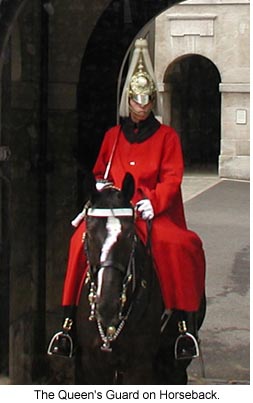 Trooping the Colour takes place each June -- in 2005 it will be on June 11th -- to mark the Queen's official birthday. Her actual birthday is in April, but it has long been traditional for a public celebration for the monarch's birthday to be held during the summer, when the vagaries of the British climate are less likely to spoil proceedings.
Trooping the Colour takes place each June -- in 2005 it will be on June 11th -- to mark the Queen's official birthday. Her actual birthday is in April, but it has long been traditional for a public celebration for the monarch's birthday to be held during the summer, when the vagaries of the British climate are less likely to spoil proceedings.
The history of trooping the colour began early in the 18th century. Originally known as 'Lodging the Colours', it entailed gathering all the soldiers of a battalion together every day and marching their regimental flags, or colours, past them. Since these flags would be used as rallying signals in battles, it was essential that everyone be able to recognise them instantly. This daily display ensured that no soldier would be in any doubt as to which flags he should follow in battle. In 1748, it was decided to include this march past as part of the monarch's birthday celebrations.
It wasn't until Edward VII became king in 1901, however, that it became a regular occurrence for the monarch to take an active part in the annual parade. In 1914 George V extended the ceremony again, to include the sovereign, after inspecting the royal troops on Horse Guards Parade and leading them down the Mall to Buckingham Palace.
Queen Elizabeth II now carries out this duty, and it's one of the ceremonial highlights of the year, with thousands of people lining the processional route. After inspecting the troops, she leads them, accompanied by massed bands, back to Buckingham Palace, where she then appears on the balcony to receive the fly past from the Royal Air Force and a gun salute from the Tower of London.
The Order of the Garter
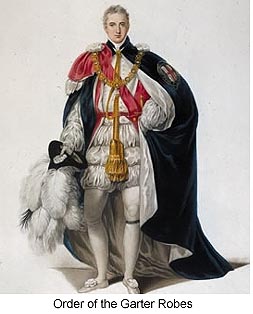 Also in June is the ceremony of the Order of the Garter, held at Windsor Castle. The Order of the Garter is the most prestigious and oldest British Order of Chivalry, founded by Edward III in 1348. Inspired by tales of Arthur and his Knights of the Round Table, Edward decided to create his own band of select knights, 26 in all, whom he considered the most outstanding military minds of his court (there are more now, including women, who are known as Lady Companions).
Also in June is the ceremony of the Order of the Garter, held at Windsor Castle. The Order of the Garter is the most prestigious and oldest British Order of Chivalry, founded by Edward III in 1348. Inspired by tales of Arthur and his Knights of the Round Table, Edward decided to create his own band of select knights, 26 in all, whom he considered the most outstanding military minds of his court (there are more now, including women, who are known as Lady Companions).
For several hundred years, the king and his knights met annually for a three-day select celebration of religious devotion and feasting at Windsor. From the latter part of the 17th century, the celebrations became less frequent; in 1805 the Garter ceremonies more or less stopped. New knights were still created, but there was a decided lack of pomp and circumstance until 1948, when George VI reinstated a formal investiture of new knights, with a renewed annual ceremony.
Today Garter Knights, dressed in their flamboyant robes, assemble at Windsor Castle and then walk through the grounds, through the Upper, Middle and Lower Wards of the castle to St George's Chapel. The procession is led by the Constable and Governor of Windsor Castle and the Military Knights of Windsor. Members of the public are admitted to the castle grounds to watch the procession. Tickets are allocated each year in a ballot administered by St. George's Chapel.
Opening of Parliament
Two other spectacular historical parades worth seeing occur in November. The State Opening of Parliament, an event that dates back to medieval times, sees the Queen travelling in the Irish State Coach (so-called because it was crafted by the then-Lord Mayor of Dublin, in 1851) from Buckingham Palace to the House of Lords. She is accompanied by military bands and her troops of the Household Cavalry and Foot Guards. Before she enters the House, the Yeoman of the Guard will search the cellars beneath the Houses of Parliament. This tradition dates back to 1605, when on 5th November, Guy Fawkes was arrested for planting explosives there in an attempt to blow up the Houses. Fawkes was tried for treason and executed in January 1606. This year, the 400th anniversary of the Gunpowder Plot, as it's known, will be marked by an exhibition to be held in Westminster Hall in the Palace of Westminster from July to November.
The Queen, dressed in full regalia (the State Crown and Sword of State travel in their own coach in the procession), will read the Queen's Speech to start the new parliamentary session from the throne in the House of Lords. Representatives from the House of Commons also attend-- in a symbolic gesture, an usher acting as the Sovereign's Messenger summons them to the House of Lords. The door to the House of Commons is ritually slammed in his face, and only opened after he knocks on it three times, to indicate that the Commons may refuse anyone except the Sovereign's representative.
Lord Mayor's Show
Also in November is the Lord Mayor's Show, a 400-year-old ceremony at which the Lord Mayor of London declares fealty to the monarchy. The first Lord Mayor was Henry Fitz-Ailwyn, in 1189, though it's Dick Whittington who is probably the most famous. A favourite pantomime character, he did exist and was actually Mayor three times in the late 14th and early 15th centuries, though there's no record of him ever actually owning a cat, black or otherwise.
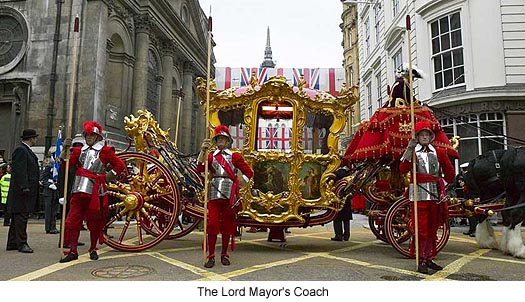
The Lord Mayor's Show has become an all-day celebration, a parade of several thousand people and dozens of floats accompanying the Lord Mayor in the State Coach from Guildhall, the centre of civic government, to the Royal Courts of Justice, where the Mayor will swear an oath of loyalty to the Queen. A fireworks display from the Thames will finish the day.
The Changing of the Guards
In addition to these, there are daily ceremonies that have been a part of court tradition for hundreds of years. A major tourist attraction, the Changing of the Guards takes place at a number of royal sites. Despite its fame today, Buckingham Palace didn't actually become the main royal home in London until 1837, when Queen Victoria decided to live there rather than at St James's Palace. St James's was built in the 1530s by Henry VIII, and several members of the royal family lived there between then and 1698, when it became the official residence of the monarch after the Palace of Whitehall burned down. In fact, St James's is still the official royal residence, even though the Queen lives mainly at Buckingham Palace, and it's at St James's that foreign ambassadors are received at court.
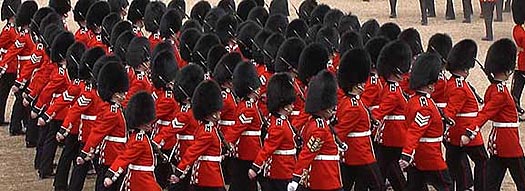
The Household Guard has protected the royal palaces since 1660, and guards are now posted at Windsor Castle, on Horse Guards Parade and St James's as well as at Buckingham Palace. The Household Cavalry Mounted Regiment is on continual guard at Horse Guards -- the official entrance to Buckingham and St James's Palaces -- and you can watch the ceremonial Changing of the Guard there daily. The Queen's Guard stand at Buckingham Palace and St James's and the 45-minute ceremony is carried out daily during the summer months and on alternate days throughout the winter, where the New Guard replaces the old, first at Buckingham Palace, then marching down to St James's to relieve the Old Guard there too.
At Windsor, built by William the conqueror over 900 years ago to defend the city from the west and another of the Queen's official residences, there is also a permanent guard mounted. In the summer, if the Queen is in residence, you can see the guards march through the town accompanied by a band, as the guard is changed.
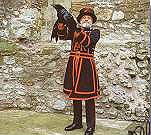 One final, though less public, ceremony is the Ceremony of the Keys. This too is a daily event, and started back in the 14th century when the Yeoman Warders -- more commonly now known as the 'Beefeaters' -- began their long tradition of looking after the Tower of London. Every night, at precisely 9.53 pm, the Chief Warder will walk from the Byward Tower to the Tower gates. Once all gates have been secured, a trumpeter will sound the last post. The ceremony takes only a few minutes, but it has been followed for hundreds of years and will continue, whether anyone is there to watch it or not. It's free to attend, although you do have to apply for a ticket a couple of months on advance (call +44 (0)20 7709 0765).
One final, though less public, ceremony is the Ceremony of the Keys. This too is a daily event, and started back in the 14th century when the Yeoman Warders -- more commonly now known as the 'Beefeaters' -- began their long tradition of looking after the Tower of London. Every night, at precisely 9.53 pm, the Chief Warder will walk from the Byward Tower to the Tower gates. Once all gates have been secured, a trumpeter will sound the last post. The ceremony takes only a few minutes, but it has been followed for hundreds of years and will continue, whether anyone is there to watch it or not. It's free to attend, although you do have to apply for a ticket a couple of months on advance (call +44 (0)20 7709 0765).
If you enjoy the spectacle of pageantry, the glitter of crowns and coronets, or the sight of ancient traditions that have survived into this technological age, London's palaces and processions give you a real glimpse into the splendour of the British court.
More Information:
We regret that we no longer have the resources to maintain up-to-date links and/or hours and pricing details for the various sites and attractions listed on this website. For more information about the location(s) listed above, please use your favorite search engine or visit Wikipedia.
Louise Simmons is a Scottish freelance writer who lives in a 19th century farmhouse on the top of a hill in the middle of a sheep-farming area of central Scotland. An engineer by profession, after spending many years working in the IT industry in such unusual places as Nigeria, Russia and various oil rigs in the middle of the North Sea, she decided to take up her favourite occupation, writing, on a full-time basis, and currently writes for several on-line and print magazines. She particularly enjoys researching and writing about the history and culture of British people and places. Louise's website is at http://www.grayrigg.com.
Article © 2005 Louise Simmons
Photos courtesy of the Corporation of London Press Office
(Order of the Garter photo courtesy of Wikipedia.com)
|
